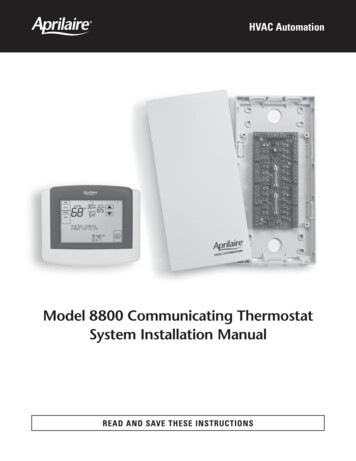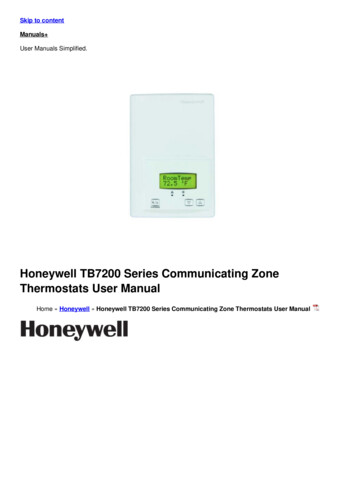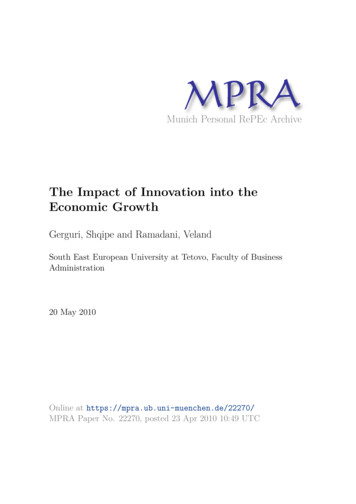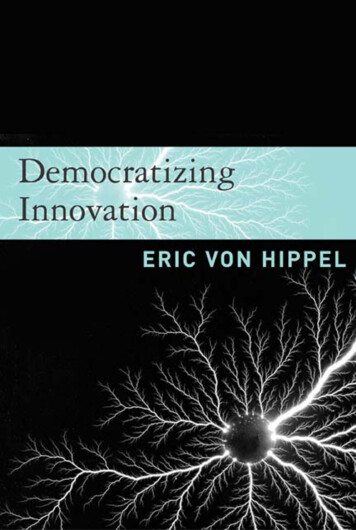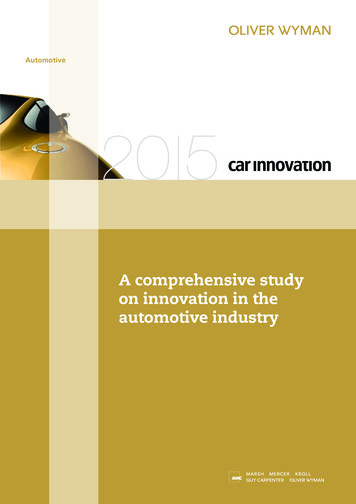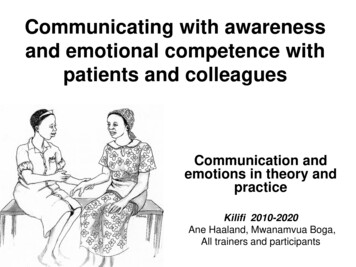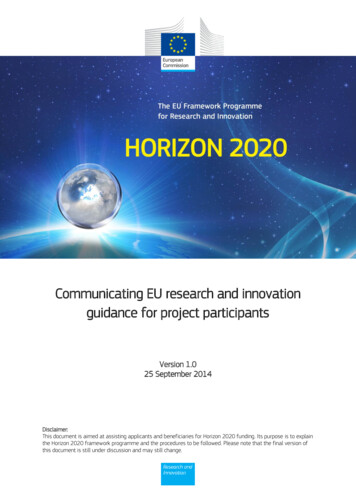
Transcription
Communicating EU research and innovationguidance for project participantsVersion 1.025 September 2014Disclaimer:This document is aimed at assisting applicants and beneficiaries for Horizon 2020 funding. Its purpose is to explainthe Horizon 2020 framework programme and the procedures to be followed. Please note that the final version ofthis document is still under discussion and may still change.
Communicating EU research and innovationguidance for project participantsCommunication, why?Communication, dissemination and exploitation — a team working on H2020 project is called uponto take part in various activities that will bring their research to the attention of as many relevantpeople as possible.What we call here ‘communication’ is more than just an additional reporting burden. Europe'sfuture economic growth and jobs will increasingly have to come from innovation in products,services and business models. With this in mind, communication about European research projectsshould aim to demonstrate the ways in which research and innovation is contributing to a European'Innovation Union' and account for public spending by providing tangible proof that collaborativeresearch adds value by: showing how European collaboration has achieved more than would have otherwisebeen possible, notably in achieving scientific excellence, contributing to competitivenessand solving societal challenges; showing how the outcomes are relevant to our everyday lives, by creating jobs,introducing novel technologies, or making our lives more comfortable in other ways; making better use of the results, by making sure they are taken up by decision-makersto influence policy-making and by industry and the scientific community to ensure follow-up.There is an enormous difference between communication strategically planned with theseobjectives in mind and ad hoc efforts for the sake of meeting contractual requirements. How oftendo we hear people say ‘let's make a video to inform everyone’ before giving any thought to what isto be achieved? How often do we resort to facts and figures, assuming they will be enough toconvince people? Your contractual obligations are important, but communication is not an end initself and quality is expected. We hope this guide will help you avoid some common mistakes:Common mistakes: non-strategic communicationBetter practice: strategic communicationFocus on media before messageTargets, audience and message clarified beforedeciding on the mediaCreative people come up with a ‘cool’ ideaCreative people plan to achieve desired outcomes‘Why’ or ‘what’ questions are left unansweredObjectives are clearly definedWhat's in it for you?With a little creativity, strategic communication can help publicise your work in such a way that youwill profit. Suitably framed messages can help to: Increase the success rate of your proposal (provided you have a good communication anddissemination plan); Draw the attention of national governments, regional authorities and other public and privatefunding sources to the need for and ultimate benefits of (your) research; Attract the interest of potential partners; Encourage talented students and scientists to join your partner institutes andenterprises; Enhance your reputation and visibility at local, national and international level; Help the search for financial backers, licensees or industrial implementers to exploit yourresults; Generate market demand for the products or services developed.This short guide will help you attain these outcomes. You will be inspired by some good practicesemanating from fellow project coordinators. And you will find a helpful checklist for improving yourown communication activities right from the start of your project.Finally, the European Commission will be only too pleased to spread the word about thegood work of the projects it is supporting. Once you have some worthwhile materialavailable, there are many ways in which we can help you pass on the message.1
Good practices from projects like yours‘Communication is a way to keep all partners actively involved in the project’Jan Willem Gunnink, project coordinator, COMET:‘For me it’s only natural to put considerable effort into communicating the outcomes of our work.We receive massive amounts of taxpayers’ money to carry out fantastic projects. Letting the publicknow how this money is spent is an obvious obligation. In addition, many of our consortiumpartners share a commercial interest in exploiting our results. So we invest up to 10% of ourresources in communication and dissemination activities.The communication plan that we drafted at the start of our project includes a variety of tools andideas to help ensure that Europe’s manufacturing industries quickly understand the objectives ofour COMET project and the potential impact of using robots for cost-effective, high precisionmanufacturing in factories of the future. It also includes the consortium’s procedures fordisseminating information: partners always get the chance to check whether the information iscorrect or perhaps confidential.Communication is certainly a way to keep all partners actively involved in the project. We decidedto invest in small gadgets and materials with the project’s name on them. You’d be surprised of theeffect a simple sticker displaying the project’s name on a robot can have. Similarly, we made surethat banners with the project’s name were available right from the beginning.Most of the work is carried out jointly with the marketing department of the coordinating company,but we do ask all work package leaders to contribute a little to generating noise around our project.For example, they each submit one ‘tweet’ a month for our Twitter account. We also have about1000 subscribers to a digital newsletter and we make sure all partners get their share of visibility.This is resulting in numerous expressions of interest in our products. I think it’s somehow similar tohow washing powder is advertised: show up everywhere and it pays off.The best advertisement, however,is demonstrating a workingproduct. This spring we willorganise what we call ‘opentraining days’ in several countries.Anyone interested will be welcometo learn about our work and see ademonstration of what ouradvanced robots can do.Communication is not somethingthat you give to someone as a taskon the side; it’s really one of themost important aspects of runninga successful project.’Twitter feed: https://twitter.com/COMET project2
‘People are even taking it on themselves to call our scientists’Marilou Ramos Pamplona, project coordinator, Lupa:‘In our project, we use information about dogs’ genetics to improve our understanding of diseasesthat occur in both dogs and humans. For the collection of DNA samples our scientists spend a lot oftime communicating with dog owners, breeding clubs, vets and people at dog shows.Our communication activity is very decentralised, as it must take into account the specifics of eachof the twelve countries that we work in. All of our scientists have direct access to flyers andposters. They keep an eye on relevant events in their regions, contact dog shows to ask for a boothand talk to as many dog owners and breeders as they can.We publish information about our work in popular journals for pet lovers, all the way through theproject and as soon as results become available. In our articles, we ask people to submit samplesand we explain our findings. Those can be used to screen dogs for particular diseases, so they areof interest to this same community. The scientific credibility of our findings obviously relies on ourresearch basis. Our communication with the broader public is never secondary to publishing inhigh-profile journals like Nature or Science. Quite the contrary: we issue a press release for generalpublications whenever our work is taken up by journals of good standing.A prerequisite of communication is to acquire a good understanding of the ways your targetaudience will respond to your message. Some dog lovers fear that our research might hurt dogs.Dealing with animal welfare issues right at the start of our presentations helps to ensure a positiveresponse. I am impressed to see that our approach does not just encourage people to let us takeDNA samples; they are even taking it on themselves to call the scientists whenever they find adisease in one of their breeds.’3
It is worthwhile to collaborate with others to amplify your workMichele Cocco, project coordinator, Argomarine:‘Our project deals with signalling oil spills and predicting their evolution. Rather than focusingexclusively on the small circle of scientists working in this field, we have also tried to involve peopleto whom the preservation of the marine environment — and hence our project — is relevant. Forexample, we have been organising localworkshops with coastguards andmunicipalities. We have also produced anapplet for smartphones that can be used bypeople at sea — like recreational sailors,fishermen and scuba divers — to report oilspills when they find any.Sending out a press release is a good way topromote these actions. For us, it was helpful toinclude a link to a video clip that introducedour work. We hired professionals for that, sothat the imagery and style were veryaccessible. Professionals have also recentlyhelped us in creating a social media presence,which has definitely increased our visibility. Ithink it would be advisable to dedicate abudget to this type of assistance right from thestart of a project.Being active in communication meant that I, as the coordinator, encouraged all the partners tothink about what we could do. It also means having the contacts and resources to react in a timelyand efficient way whenever something happens that could be relevant to your work. In our case,right after the accident with the Costa Concordia ship, the partners discussed whether we couldsomehow respond. Since one of the main concerns at the time was possible oil leakages, wedecided to make a simulation and issued a press release. This resulted in plenty of reactions.Finally, we found it worthwhile to profit from existing meetings and conferences and to collaboratewith others to amplify our work. As an example, our final workshop will take place at the MaritimeDays, where thousands of people will be present. We have also established contacts with anotherEU-funded research project working on a closely related topic. I expect that we will organise across-project demonstration soon.’Project video: http://youtu.be/ 5biJLVZjxg4
The key to a successful media campaign is in the planningColin Smith (media officer) and Emile Greenhalgh (project coordinator), STORAGE:‘The STORAGE project has attracted quite a lot of attention, ranging from Der Spiegel to the NewYork Times. As a result, there has been considerable interest in the technologies being developedand the subsequent impact they could have on future automotive applications (and beyond). Infact, Volvo has estimated that the advertising exposure from the STORAGE project has been worth 112 million, from the press release (January 2010) up to May 2011. If you set that off against thecost, it is good value for money! To give an idea of what it involves for a team of researchers: Initial meeting (1 hour) — This involvesmeeting with your press officer todiscuss the project. The press officer willneed to take notes for the press releaseand work out the campaign timeline.Editing process (1 hour) — A draftrelease will come back to you forapproval. You will need to look at therelease to ensure the copy is accurate.Speaking to the press — As a rule ofthumb, always remember that broadcast(TV) will take the most time and onlinemedia may take the least amount of timeas they tend to use press releasesverbatim.Interviews (1-2 hours) — If your storyhas a really interesting visual element,always remember that the broadcastpress may want to come and interviewyou in a lab. You may need to invest extra time preparing the lab for filming.Long-term support — Be prepared to put some long-term support into your press campaign if ithas been very successful, as you may get further coverage in other countries over a longerperiod of time. You may also get calls for collaborations and enquiries about your research fromfunders and other stakeholders. Develop a plan for responding to enquiries in a timely way. Forexample, a web page you can refer people to, which will reduce the time spent repeatinggeneral information to callers.After issuing our press release, we received a huge number of queries from the press as well asapproaches from industry for more information about STORAGE. For example, we received aninvitation and funding to visit Singapore and Canada (Montreal), organised by the FCO to presentthe technologies to researchers and industries in these countries, with the aim of initiating futurecollaborations. Similarly, exposure from STORAGE led to the project coordinator being invited byTourism London to represent London.If we were to give a single tip for future project coordinators, it would be this: the key to asuccessful media campaign is in the planning. Before you even begin a campaign, it is importantthat the key people involved all agree on the answers to the following: What do we want to achieve with this publicity? For example, do we want more students toapply to our department? Do we want funding? Do we want the public to learn about thisinteresting area of research and innovation?Who are our audiences? Are they schoolchildren, other academics, policymakers, business,industry or the general public interested in science?How will we achieve our objectives?’5
‘It is very important to know who you want to reach’Oscar Valdemoros Tobia, project coordinator, EPOSbed:‘Small and medium-sized companies do not always have a lot of resources. I am doing a largeshare of the communication work myself, together with the person in charge of marketing andcommunication at our company. Despite this restraint, our project has been quite successfullycommunicated, not least because we profited a lot from the support we got from European andlocal authorities.As an example, we closely involved local politicians in our project. When the head of a publicinstitution comes to visit your factory, he will automatically be followed by the press. In this way itwas easier for us to get press coverage. It is important to involve decision-makers and politiciansanyway, inviting them to your meetings and keeping theminformed, because they can help pave the way for your next steps.In our case, this helped us to arrange for the real-life testing ofour product in a public hospital.The European Commission supported us by introducing our workto Euronews, who produced a professional video about EPOSbed.We simply distributed the video and uploaded it to our YouTubechannel. This has resulted in calls from throughout Europe, andalso from North America and Brazil.The technologies we use are complex — our medical beds rely onartificial intelligence — but that doesn’t mean that it’s impossibleto explain our work to people. The bed we developed has a clearmedical significance. It can, for example, be used by people whoare homebound and do not receive full-time care. Anyone cangrasp the actual application of the technology.One thing I learned through working on this project is that it is very important to know who youwant to reach. You need to focus your efforts on a clear target audience to maximise yourinvestment. We spent a considerable amount of time and money on attending one large Europeanexhibition. Although it did give us wide exposure, the people there were mostly from academia. Wehave realised that it is more important for us at this stage to go to places where we can findpotential customers. I now prefer going to trade fairs instead.’Website: http://eposbed.pera.com/6
Build your own communication strategy – a checklistA. Ensure good management1 2 3 Have resources been allocated (time and money)?Does your proposal include a work package on communication?Have you prepared a communication strategy and timeline?Does the communication element of the project involve all consortium partners (and theirrespective staff, including researchers)?Is there awareness that communication is a continuous process, not a one-time effort when theproject ends?Are you ready for the unexpected? Have you thought about how to respond effectively to suchthings as publication in high-ranking journals or a sudden new event related to the project’stheme?Are professional communicators involved?Have resources been allocatedto professional assistance withthe drafting of press releases,graphic design, maintenanceof the website and othercommunication tasks? Largerinstitutions usually have an inhouse capacity for this.Have you considered takingany training in the field ofcommunication or including acommunication expert in yourteam?A word of warningWhen working with external professionals, the costs of hiring themneed to be justifiable economically and in terms of effectiveness.Shopping around among several service providers can assure bestvalue for money.We are aware that from time to time participants in projects fundedunder the framework programmes are contacted — often by telephone— by organisations seeking payment in return forpublishing information on the work being done in their projects. Aswith ‘cold calling’ in general, the claims and assertions made should betreated with appropriate caution before deciding on the best course ofaction. Contrary to some of the ‘sales pitches’ used, thesepublications and their services have not been endorsed by theCommission. Common tactics to secure business include vaguereferences to high-level contributions from decision-makers, or makingproject participants believe that their activities have been singled outon account of special merit, which may not be the case.Is continuity ensured?Are there any arrangements to ensure that information will not be lost once the project comesto an end?Does the project provide for any feedback loops back to the European Commission that canhelp with amplifying the message, for example by notifying an event, or before publishing apress release?B. Define your goals and objectives1 Are there any goals and objectives?Have the final and intermediate communication aims of the project been specified, what impactis intended, what reaction or change is expected from the target audience? For example:o Receiving feedback or engaging in dialogueo Influencing the attitudes of decision-makerso Having people make a decision or take actiono Ensuring that the project outcomes will be taken into production7
2 Are your goals and objectives neither too ambitious nor too weak?Is there a deadline by which the goals should be achieved, taking into account different stagesof the research and possible intermediary outcomes?Are the objectives specific and measurable, rather than vague? Does the project envisage waysof measuring its communication efforts and impact? For example:o Evidence of debates in the mediao Evidence of new funders for your areao Evidence of transfer of research and innovation into practice (patents, prototypes, licenses)o Number and turnover of new products, practices or procedures developed, based on yourresearch outcomeso Number of articles in the presso Number of people asking for feedback or more informationo Number of references in scientific publicationso Participation in project events and seminarso Speaker evaluations from conference presentationso Survey of end-userso Trends in website visitsC. Pick your audience1 2 Is your audience well defined?Is each target audience a relatively homogenous group of people (not: ‘the public at large’ or‘all stakeholders’)?Can the indicated audiences be further specified? For example: from ‘the general public’ to‘female citizens commuting by train to work in one of the EU-10 countries’ or from ‘decisionmakers’ to ‘Europarliamentarians involved in the design of the new transport policy 2013’.Does it include all relevant target groups?Can your audience help you reach your objectives?o Who has an interest in your research?o Who can contribute to your work?o Who would be interested in learning about the project's findings?o Who could or will be affected directly by the outcomes of the research?o Who are not directly involved, but could have influence elsewhere?Does the project aim to address both a direct audience and intermediaries to reach morepeople?What about the possibility of audiences at local, regional, national and European level?Is the audience external (not restricted to consortium partners)?For each audience, you should work on a distinct strategy using targetedmessages, means and language.8
D. Choose your message1 Is it news?Why do we need to know?Tell a story, don’t just list factsWhat will change? Whatsolutions are you offering?A story is an effective way to make people remember your message.Why not tell one to disseminate your results?What makes the issue urgent?What are the consequences ifWhich stories work best? A good story consists of a succession ofno action is taken?events with a beginning, a middle and an end, a scene setter and aHave you tried to stir yourplot, a climax and a conclusion, all of this in a rich context. It is henceaudience's imagination andmore than a list of results achieved. A good story is one with whichothers can identify, with the project content as a basis, and focused onemotions?a person (for example: the researcher). Such stories also allow yourHow does your work relate tomessage to be conveyed through shared values that will touch people'severyday life? Does it link tohearts and provoke emotion, and the promise of a better future.any broader societal issue?Rather than focusing only onYou have forgotten how to tell a story? There are plenty ofresources on the internet to help you. Just search for 'storytelling'.the provision of factualinformation, is your projectresearch positioned within a broader socio-economic and policy context, so that it will be easierto explain the results and their relevance to policymakers and citizens?2Are you connecting to what your audience wants to know? See through your audience's eyes:o What do they already know about the topic?o What do they think about it?o Do they need information and/or persuasion?o Have you tested your message?3Are you connecting to your own communication objectives?E. Use the right medium and means1 2 Do they reach the audience?Are you working at the right level (local, regional, national)?Are you using dissemination partners and multipliers? Dissemination partners can help amplifyand multiply a message. Rather than aiming to build an audience from scratch, the projectshould indicate which partners to use and how.Do they go beyond the obvious?If input or contributions are needed, are there mechanisms in place to make communicationinteractive so as to obtain responses?Are you taking into account the different ways to communicate?9
Examples of interpersonal , two-waycommunication- Dialogues, face-to-face conversation- Group discussions- Conferences- Brokerage events- School visits- Tours- Round tables- Exhibitions- Meetings- Workshops- Open days- Demonstrations and prototypes- Telephone calls- E-mail information service (question and answer)- Internet debateExamples of mass media, one-waycommunication- Newspapers and magazines- Press releases- Newsletters- Manuals- Brochures, booklets, flyers- Letters- Radio- Television- Video- Posters- Stickers- Banners- Billboards- Website- Policy briefsSmaller audience, lower costs, more effort (moreeffect?!)Interactive, good for acquiring inputFlexible (easy to change tone, strategy and content)Potentially large audienceUses the credibility of the mass mediaF. Evaluate your efforts Go back to your goals and objectives. Have they been reached? What lessons haveyou learned?10
How can we help you?Whether your project is organising a public event or press demonstration, or has just delivered aset of exciting results: the European Commission may be able to help you spread the word. Do notforget to inform your Project Officer about interesting topics, news and events concerning yourproject. We can help raise your profile. In addition, several freely accessible tools are at yourdisposal:PublicationsHorizon Magazinehttp://horizon-magazine.eu/HORIZON is the EU Research &Innovation e-magazine. It iscovering the latest developments inEU funded research and innovation,communicating the priorities andachievements of EU-fundedresearch, its impact on citizens' livesand its contribution to the EU goalsof smart and sustainable growth.For story suggestions orquestions to the editor,e-mail: RTDPUBLICATIONS@ec.europa.euIt is written by independentjournalists on behalf of DG Research& Innovation and is updated at leastthree times a week with newarticles.Project /en/newsroom/551/Articles about selected EU-fundedresearch projects, which led tobreakthroughs, discoveries andworld-firsts by taking great ideasfrom the lab to the market, at thesame time contributing to economicgrowth and creating jobs, andtackling societal challenges.Please contact your ProjectOfficer about any interestingproject outcomes.This print magazine featureshighlights from the EU-fundedresearch and development projects.It is published 10 times per year inEnglish, and covers mainly theresearch areas of biology andmedicine, Social sciences andhumanities, energy and transport,environment and society, IT andtelecommunications, industrialtechnologies and space.Please contact your ProjectOfficer about any interestingproject outcomes.This print magazine covers in eachissue a specific topic of researchinterest. It features articles on EUpolicies, initiatives, programmes andprojects related to research andtechnological development and theirexploitation. It is published atirregular intervals up to six times ayear in English. Exceptionally, it maybe available in other Europeanlanguages as well.Please contact your ProjectOfficer about any interestingproject x.cfm?pg publications&lg enNewsletters are published by theEuropean Commission for differentresearch areas.Please contact your ProjectOfficer to get moreinformation on how to publishsomething in a specificnewsletter.Co-publications or editorialpartnershipsThe European Commission workswith private publishers andinternational organisations topromote the dissemination ofrelevant publications. Scientificpublications and books, includingconference proceedings, may be copublished in this way.Please contact your ProjectOfficer to discuss thepossibilities.research*eu results magazinewww.cordis.europa.eu/researcheu/magazine en.htmlresearch*eu s en.htmlFurthermore a journalistcontracted by the EuropeanCommission may contact you.Furthermore a journalistcontracted by the EuropeanCommission may contact you.A journalist contracted by theEuropean Commission maycontact you.11
AudiovisualFuturis hort documentary-style televisionmagazine in various languages,appearing at least 22 times on theEuroNews channel throughoutEurope.EuroNews has editorialindependence, but we are incontact with them tosuggest good stories. Sinceit is television, this isinteresting for visuallyappealing projects anddemonstration activities.Please contact your ProjectOfficer if you would likeyour project to be putforward.Events on the Commission’s Research &Innovation websitewww.ec.europa.eu/research/index.cfm?pg conferences&filter allThis website displays research andinnovation-related conferences andevents.You can submit an event byusing the “Suggest anevent” functionality which isavailable on the left-handside of the website.Events on the CORDIS websitewww.cordis.europa.eu/news/home en.htmlThis website displays researchrelated conferences and events.Submitting an eventrequires one-timeregistration on the CORDISwebsiteConferences and events organised by theEuropean CommissionThroughout the year, the EuropeanCommission (co-organises a varietyof conferences, both in Brussels andelsewhere. These may includeexhibition areas or sessions at whichyou could present your work.Please contact your ProjectOfficer if you have suitableexhibition items (prototypes,demonstrators)The Open Access Infrastructure forResearch in Europe is an electronicgateway for peer-reviewed articlesand other important scientificpublications (pre-prints orconference publications).You may submit yourpublications towww.openaire.euHeadlines on the Commission’s Research &Innovation websitewww.ec.europa.eu/research/infocentre/all headlines en.cfmHeadlines report on recentdevelopments in research andinnovation in Europe and beyondand are devoted purely to projects.Suitable stories to be published onthe site are selected on a dailybasis.You may submit your news(by means of a pressrelease, eventannouncement orotherwise) via CORDIS wirehttp://cordis.europa.eu/wireCORDIS Wirehttp://cordis.europa.eu/wire/CORDIS Wire provides registeredusers with a simple interface topublish articles on the CORDISwebsite’s News and Events service.All articles are moderated byCORDIS editors before publication.Requires one-timeregistration athttp://cordis.europa.eu/wireEventsOpen access scientific publishingOpenairewww.openaire.euOnline news12
Sources and resourcesThis list includes a number of sources that we have found useful as a starting point. It is by nomeans exhaustive. In fact, it is likely that guides dealing specifically with your research field exist.A quick search or a check with your national academy of sciences may also reveal guides onscientific communication that have been written in your langua
This short guide will help you attain these outcomes. You will be inspired by some good practices emanating from fellow project coordinators. And you will find a helpful checklist for improving your own communication activities right from the start of your project. Finally, the European Commission will be only too pleased to spread the word .


